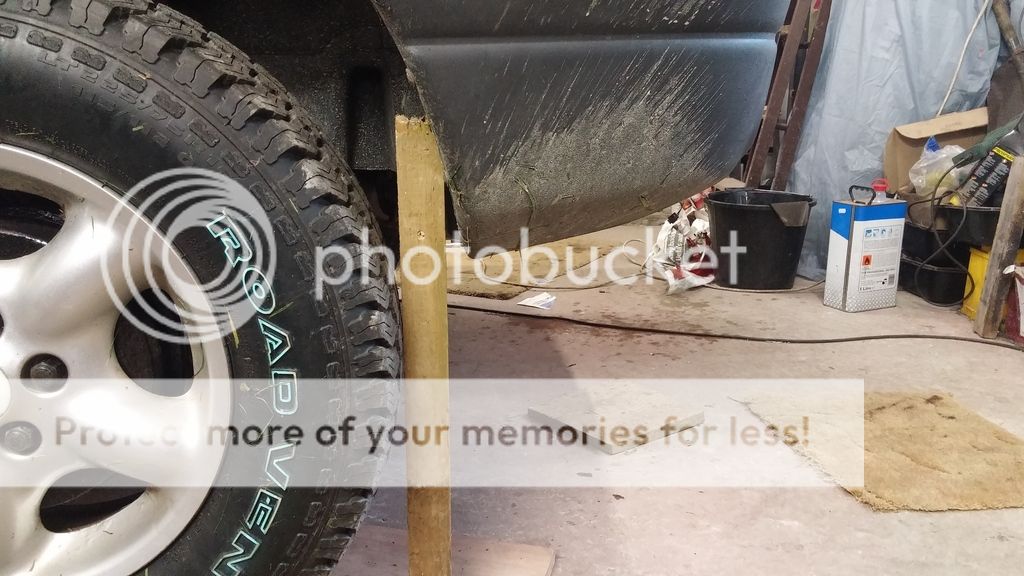Joe_H
Well-Known Member
- Posts
- 1,486
- Location
- Brit in Northern Portugal
YOU KEEP YER GRUBBY MITS ORF MY MOTOR YA BIG BALIX!Here ya go @Alibro
Just got the gas axe out and shifted the rear wheel for ya.....
Just need some tweaks to the arches now
View attachment 108984
Nope - chopped yer arches too and tee cut the bl00dy thing ya idle beggarYOU KEEP YER GRUBBY MITS ORF MY MOTOR YA BIG BALIX!
As lift kits have been sold for years and many folk here have them without complaint I'm not overly concerned about the potential issues.Edit - this started as a quick response ..- but... forgive any math errors or otherwise.. it is early and I have been up since 5 AM..... if any of my angles are t!ts up then please let me know..
Hi GG, you are absolutely correct and of course the amount of movement is related to the increased angles. If you take - for example - a hypothetical 500mm trailing arm at horizontal with a pivot point at one end - (x), call the 'movable' end (y) then if you 'drop' (y) 50mm from the horizontal the movement in the longitudinal axis is less than 3mm. - however, if you drop it 200mm then the longitudinal 'shift' is around 39mm.
LR originally set the suspension so that the trailing arm was inclined downwards when normally laden so that the wheel moves 'backwards' as bump increases. max drop angle (down from horizontal) was always greater than the max bump angle (up from horizontal) .. so as we approach high defections upwards there is a virtually null area.
ie, - from 5 degrees 'down' from horizontal to 5 degrees 'up' - the longitudinal shift is only +/- 2.5mm. if the arm is set - at normal laden conditions - at, say, an angle of 15 degrees 'down' then for the first 10 degrees of movement (which is a 'bump' of about 100mm) the shift is around 20mm to the rear. As above though, once it approaches and passes horizontal -5 to +5 degrees the shift is only +/- 2.5mm.
Herein lies the problem with 'lift kits' if you do not alter the suspension arm fixed pivot points at the same time.
All you can do (if you are not prepared to alter the fixed points) is to find a compromise so that the wheel 'looks' ok and remains clear of the arches through the range of travel. The issue with the rear wheel being close to the forward arch is that as 'drop' increases - which it certainly will off road! - then the wheel will move forward at a much greater rate. The shift from a static angle of - 10 to -15 is a movement of 12 mm towards the arch, however, from 15 to 20 is a further 16mm.and from 20 to 25 is another 30mm !!!!
So with a horizontal arm of 500 mm at 0 degree drop there is no deflection of course, but the FORWARD movement of the end of the arm (y) from the horizontal / 0 degrees are approximately -
5 degrees = 2.5mm
10 degrees = 10mm
15 degrees = 22mm
20 degrees = 37mm
25 degrees = 70mm !!!!
extremely non linear as would be expected. - and that equates to a downward movement from the horizontal of around 250 mm.
Whether this amount of drop is actually achievable (FROM THE HORIZONTAL ARM ANGLE) with the FL suspension when the 50mm lift is added I do not know - It would be useful to know the full range of a normal setup suspension travel from full bump to full drop - but shows the huge increases in wheel shift as the angle increases. As the kit has increased the downward angle of the lower arm we can see the results on the wheel movement already in the images, and this will only increase at a non linear rate as the wheel drops
So - by fitting a lifting kit (at the rear)we hit two issues - well FOUR actually....
First is that the trailing arm is deflected down at a greater angle than design leading to the issues above - a MUCH greater amount of longitudinal wheel movement in drop or bump.
Also, if the angle of the trailing arm is increased downwards at rest - as it is due to the lift, then the position of the wheel will move rearward as the bump increases FAR more than was originally designed. A wheel set at arch centre on a raised kit may well move backward up to 70 mm depending on the length of the arm - and that is only to the pint of the arm being horizontal !. the 70mm is for a 500mm arm at 25 degrees down from horizontal (at rest) - greater angles will cause greater shift.
The wheel could well hit the REAR of the arch under bump.
The 'sweet spot' that the manufacturer builds in - ie the point where under normal expected high bump the arm effectively pivots around horizontal giving minimal movement after the initial rear shift is lost as the vast majority of the travel is below horizontal.
The camber is positively increased far more than standard when static and is only exacerbated under droop / drop
The toe in is increased far more than than standard when static and is only exacerbated under droop / drop
So, it ends up a real hotch potch to say the least.
All that can be done really is to get the wheel in a position where it clears everything through the full travel range and also where possible is aesthetically pleasing.
Increasing the trailing arm length is actually beneficial as it reduces the rearward deflection on bump..
A 500 mm arm would show a horizontal deflection of around 70 mm at 25 degrees whereas a 530mm arm would only deflect 56mm at 25 degrees and the added bonus is that for the same drop the angle is reduced with the longer arm.
It is a can of worms really.
The rear can cause some quite unpredictable handling on road. - to say the least.
The front though ... is a complete new ball game.
The freelander though is not a sports car, however, at the front the biggest concerns would be caster shift, camber, tracking and bump steer all of which are potentially dangerous - some alarmingly so.
Then there are the deflection changes - the above potential 'issues' for the front are merely presuming the differences from 'normal' remain STATIC - they dont - they always shift with movement but the manufacturer allows for this. By making a considerable change this all goes t!ts up - and what is 'not too much of a concern' when static can become 'yikes - adrenaline is brown' when travel shift is taken into account. (it really can be very dangerous). One would presume that the manufacturer of the 'kit' would have done all the tests and measurements and provide all the info you needed to know and appropriate advise / warnings - apologies DD - if you do this already - ..- at the very least - if the kit has not been properly assessed for changes and potentially dangerous issues, then a warning that 'it has not and you fit it completely at your own risk' should be included to warn the user and cover the seller.
What you would normally do is assemble the system without the springs and measure the important angles at full drop and full bump. .. it is a veritable minefield.
Joe
No worries Ali, whatever works for you.As lift kits have been sold for years and many folk here have them without complaint I'm not overly concerned about the potential issues.
If the car was my daily driver I might be a bit more careful about it but so long as it isn't dangerous to drive I'm happy to go ahead. I suspect this car handling badly will still be significantly better than the average Disco 1 or Trattor.
As I said earlier I'll take a few measurements, look at the angles and decide how much to lengthen the arms by, but I'll probably extend them enough to put the wheel in the middle of the arch when on flat level ground and see how it goes. The Tyres are not that big to be a major problem and I can always make minor adjustments to the arches if need be.
Ah ! - so you got the DD Spacers ? -- excellent - they look spot on. I actually ordered some the other day - paid by PP I thought they were damn good value !!- but - unfortunately the checkout didn't add the darn shipping. ...... When DD checked to send them out, he noticed the shipping wasn't added. Unfortunately it was going to cost nearly as much as the spacer to send them here...I agree Joe and intend to do some checking and measuring before making any final decisions but I'm hoping the rearward movement on compression will not be enough to cause a problem. I got them from DD at a very reasonable price and they look very well made.
At the minute I'm more concerned that Eurocarparts are messing me about with the parts. I knew they weren't in stock when I ordered them but got an email saying they're checking availability and price.



Welcome To LandyZone, the Land Rover Forums!
Here at LandyZone we have plenty of very knowledgable members so if you have any questions about your Land Rover or just want to connect with other Landy owners, you're in the right place.
Registering is free and easy just click here, we hope to see you on the forums soon!
